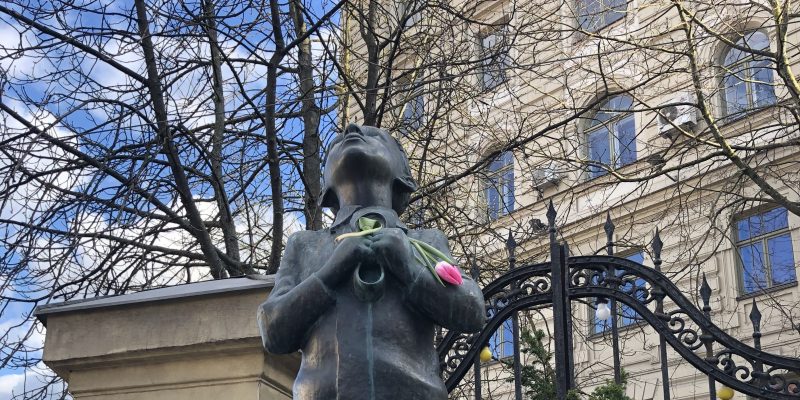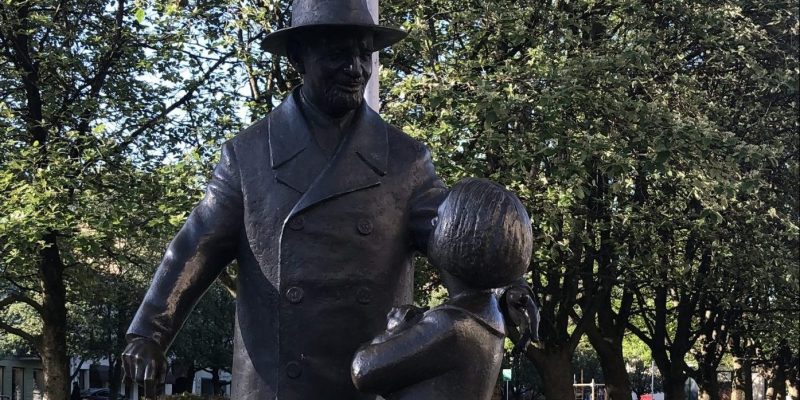WORTH TO VISIT:
The life or a writer and diplomat Romain Gary was full of adventures, and those adventures became the inspiration for several of his works. Since his childhood in Pohulanka, in Vilnius Romain was a rebellious and eccentric spirit. He never forgot Vilnius and his first love – cute Polish girl from the neighborhood, and Vilnius citizens likewise are not forgetting this talented writer – there is a sculpture next to his childhood home in Pohulanka (J. Basanavičius str.), which is inspired by his autobiographical novel “The promise of the dawn” (1960) and depicts a young boy in love – the prototype of the young Romain. The boy from the sculpture looks up to the sky and invites passers-by to notice the promising sky of Vilnius.
BRIEF HISTORY:
Romain Gary was born to Mina and Leiba Kacews in Vilnius at the dawn of the First World War – on the 8th of May, 1914. Unfortunately, the marriage of his parents was unsuccessful, so Romain stayed only with his mother in Pohulanka (nowadays – J. Basanavičius str.), the house no. 16. His father was a rich merchant, but he did not support Romain and Mina, so his mother earned the bread for the house – she owned a women clothes boutique. Mina dreamt big for the future of her talented boy and seeking a better life they emigrated to France in 1928. In the 1930s Romain Gary was granted French citizenship, he studied law and was involved in the military pilot academy. At the same time, he kept on writing – even though he has not been recognized as a legitimate writer yet. During the Second World War, he participated in military airstrikes and after the war, he had been awarded The Order of the Legion of Honor. No doubt, these achievements stimulated his career as a diplomat after the war. Only in 1962, Romain chose solely the life of the writer without any additional work responsibilities. Workaholic Romain Gary never renounced love – there were many women in his life, he married twice. His second marriage with a younger actress Jean Seberg brought him two children – Alexandre Diego and Nina Hart. However, neither love nor successful careers did not save this couple from themselves – in 1979 Jean committed a suicide, and a year later Romain went the same path by shooting himself.
THE CURRENT SITUATION:
Sometimes the novels of Romain Gary can be read without even knowing, that they belong to this author. In order to stay mysterious and intriguing, Romain created many pseudonyms for himself – Émile Ajar, Shatan Bogat, Lucien Brûlard, René Deville or Fosco Sinibaldi. This abundance of pseudonyms helped Romain to execute one of the biggest pranks for European literature in the 20th century – he won the prestigious Prix Goncourt twice. The first time Romain Gary was awarded Prix Goncourt for his novel “The Roots of Heaven” in 1956. Years later, when Romain heard gossip about his fading talent, he decided to prove them wrong – to win this prize once again. The only problem was that Prix Goncourt was given to the writer only once in this lifetime. So he wrote the novel “A life ahead of us” under the name Émile Ajar and this imaginary Émile Ajar won the Prix Goncourt in 1975. Romain Gary did not make it public, that he is the actual author of “A life ahead of us”, and the truth emerged only after his death. Thus the sculpture of a young Romain Gary in J. Basanavičius str. in Vilnius fully reflects the restless spirit of the talented writer – he never lacked artifice when he tried to prove his point.
LOOKING AROUND:
Historical Jewish quarter, 54.679532, 25.285090
Jewish street, 54.679532, 25.285090
The place of the Great Synagogue and shulhof (jid. shulhoyf) (Žydų g. 3), 54.679901, 25.284511
The mausoleum of Vilna Gaon and his family (Jewish cemetery, Sudervė road, 28), 54.712898, 25.234477
A sculpture of Vilna Gaon (Žydų g. 3), 54.680137, 25.285079
Choral synagogue Taharat ha–Kodesh (Pylimo g. 39), 54.676070, 25.281575
Užupis synagogue (Užupio g. 36), 54.681471, 25.298633
A sculpture of doctor Cemachas Šabadas (sculpt. Romualdas Kvintas), 54.677248, 25.284342
Pohulanka (dab. J. Basanavičiaus gatvė), 54.680145, 25.276134
The place of YIVO institute and its memorial plague (Vivulskio g. 18), 54.678840, 25.265085;
The place of old Jewish cemetery in Šnipiškės (Olimpiečių g. 1a), 54.690243, 25.291117
Jewish cemetery in Užupis (Olandų g. 22), 54.688106, 25.307748
The printing house of widow Rom and Rom brothers (A. Strazdelio g. 3), 54.675534, 25.292128
The writings in Žemaitija street (Žemaitijos g. 9, 54.677785, 25.281711) and in Saint Steponas street (Šv. Stepono g. 5, 54.674636, 25.281765)


